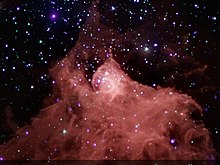Lys van stervormende gebiede in die Plaaslike Groep
Wikimedia lysartikel
Hieronder is ’n lys van stervormende gebiede in die Melkweg en Plaaslike Groep. Stervorming vind plaas in molekulêre wolke wat onstabiel raak weens swaartekraginvloede. Hierdie komplekse kan oop sterreswerms vol jong sterre bevat, asook streke van geïoniseerde gas wat H II-gebiede genoem word. Sterre vorm gewoonlik in groepe van baie lede, eerder as in afsondering.[1]

In die Melkweg
wysig| Naam | Afstand (parsek) | Ouderdom [miljoen jaar] | Tipe | Getal sterre |
|---|---|---|---|---|
| Rho Oph | ||||
| Taurus Molekulêre Wolk | 140 | |||
| Orion-newel | 415 | |||
| Westerhout 40 | 500 [2] | 0,8 [3] | Laat-O [2] | 520 [4][5] |
| RCW 36 | 700 | |||
| NGC 6334 | 1 700 | |||
| NGC 6357 | 1 700 | |||
| Arend-newel | 1 750 | |||
| Omega-newel | 2 000 | |||
| AFGL 2591 | 3 300 [6] | O9–O6 [7] | ||
| Westerhout 43 | 6 000 | |||
| Westerhout 49 | 11 000[8] | O2-3.5If*[9] |
Buite die Melkweg
wysig| Naam | Afstand (parsek) | Ouderdom [miljoen jaar] | Tipe | Getal sterre |
|---|---|---|---|---|
| 30 Doradus | 49 000 |
Verwysings
wysig- ↑ Lada, C. J.; Lada, E. A. (2003). "Embedded Clusters in Molecular Clouds". Annual Review of Astronomy & Astrophysics. 41: 57–115. Bibcode:2003ARA&A..41...57L. doi:10.1146/annurev.astro.41.011802.094844.
- ↑ 2,0 2,1 Shuping, R. Y.; et al. (2012). "Spectral Classification of the Brightest Objects in the Galactic Star-forming Region W40". Astronomical Journal. 144 (4): 116. Bibcode:2012AJ....144..116S. doi:10.1088/0004-6256/144/4/116.
- ↑ Getman, K. V.; et al. (2014). "Age Gradients in the Stellar Populations of Massive Star Forming Regions Based on a New Stellar Chronometer". Astrophysical Journal. 787 (2): 108. Bibcode:2014ApJ...787..108G. doi:10.1088/0004-637X/787/2/108.
- ↑ Kuhn, M. A.; et al. (2010). "A Chandra Observation of the Obscured Star-forming Complex W40". Astrophysical Journal. 725 (2): 2485–2506. Bibcode:2010ApJ...725.2485K. doi:10.1088/0004-637X/725/2/2485.
- ↑ Kuhn, M. A.; Getman, K. V.; Feigelson, E. D. (2015). "The Spatial Structure of Young Stellar Clusters. II. Total Young Stellar Populations". Astrophysical Journal. 802: 60. arXiv:1501.05300. Bibcode:2015ApJ...802...60K. doi:10.1088/0004-637X/802/1/60.
- ↑ Johnston, K. G.; Shepherd, D. S.; Robitaille, T. P.; Wood, K. (2013). "The standard model of low-mass star formation applied to massive stars: a multi-wavelength picture of AFGL 2591". Astronomy & Astrophysics. 551: A43, 1–23. arXiv:1212.1719. Bibcode:2013A&A...551A..43J. doi:10.1051/0004-6361/201219657.
- ↑ Sanna, A.; Reid, M. J.; Carrasco-González, C.; et al. (2012). "Clustered star formation and outflows in AFGL 2591". The Astrophysical Journal. 745 (2): 191–200. arXiv:1111.0843. Bibcode:2012ApJ...745..191S. doi:10.1088/0004-637X/745/2/191.
- ↑ Zhang, B.; et al. (2013). "Parallaxes for W49N and G048.60+0.02: Distant Star Forming Regions in the Perseus Spiral Arm". Astrophysical Journal. 775 (1): 79. Bibcode:2013ApJ...775...79Z. doi:10.1088/0004-637X/775/1/79.
- ↑ Wu, S.-W.; et al. (2014). "The discovery of a very massive star in W49". Astronomy & Astrophysics. 568: L13. Bibcode:2014A&A...568L..13W. doi:10.1051/0004-6361/201424154.
Eksterne skakels
wysig- Simbad
- Hierdie artikel is vertaal uit die Engelse Wikipedia